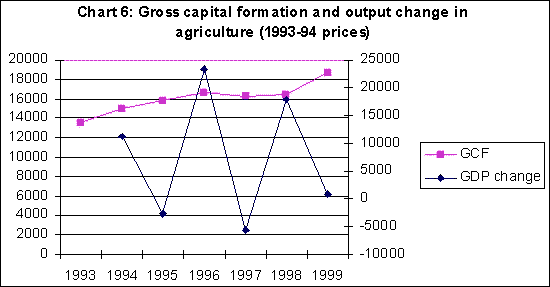|
Instead,
over the 1990s, private sector investment appears to
have risen until 1995-96, and thereafter declined to
settle at the rates observed for the late 1980s. This
increase was not sufficient to offset the decline in
public investment over the 1990s in terms of the unadjusted
total. Instead, a substantial factor in determining
the final gross capital formation figure over these
two decades appears to have been in terms of errors
and omissions.
These errors and omissions reflect the differences that
emerge when reconciling the commodity flow estimates
of investment with the financial flows that emerge also
from the balance of payments figures. Thus they amount
to domestic saving plus net capital flow from abroad
minus unadjusted gross domestic capital formation. It
is interesting to note that, while the errors and omissions
do fluctuate to some extent as expected, there is a
definite tendency to move from negative levels in the
1980s to positive levels in the 1990s. It is not clear
whether this also reflects some broader tendency which
is not being adequately captured in the data.
Chart 5 and the subsequent charts focus on the period
after 1993, since the new series of National Accounts
begins with base year 1993-94. Chart 5 is extremely
interesting because it reveals some relatively less
known aspects of the composition of capital formation.
It turns out that, insofar as investment has increased
over the 1990s, it has dominantly been due to the increase
in household investment (which is the counterpart of
household physical savings as described earlier). Private
corporate investment increased only slightly and then
tapered off from 1996-97, while public investment, as
mentioned earlier, declined over most of the decade
and only increased slightly in the last two years.

Chart
5 >> Click
to Enlarge
This has meant that, while the public sector’s share
of investment fell from 1993-94 to reach only 28 per
cent by 1999-2000, the share of private corporate investment
increased only marginally was at only 31 per cent at
the end of the decade. By contrast, the share of
investment by private households increased from 35 per
cent in 1993-94 to as much as 41 per cent by 1999-2000.
It is a moot point how much of this reflects increases
in what could otherwise be called luxury consumption,
whether in the form of luxury housing which is classified
as physical asset creation, or in the purchase of luxury
vehicles which are classified as transport equipment.
The substantial slowdown in private corporate investment
obviously reflects relatively depressed expectation
regarding the of the market in the current recessionary
conditions. But it also is bad news for the future,
since it means that future activity and output will
also be affected. The best means to reverse this would
be to reverse the downward tendency of public productive
investment, but that would in turn imply a substantial
revision and transformation of the entire economic reform
strategy of the past decade.
Charts 6 to 13 examine the patterns of gross capital
formation and change in output by specific sectors in
the period 1993-94 to 1999-2000. This obviously provides
a sectorally disaggregated sense of investment
behaviour. But it also gives a broad indication of how
output has moved relative to investment, in other words
whether ICORs (which measure the incremental output
consequent upon new investment) would have a useful
applicability in this context.

Chart
6 >> Click
to Enlarge
|

